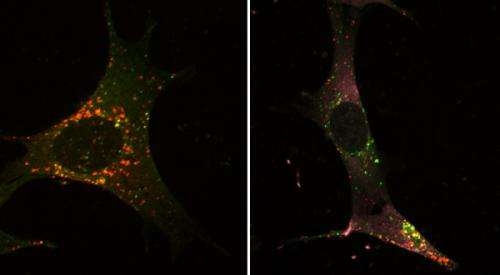The body's own recycling system: Researchers discover 'molecular emergency brake' in charge of regulating self-digestion

Times of distress literally eat away at the core of starving cells: They start to digest their own parts and recycle them for metabolic purposes. Ingo Schmitz at the Helmholtz Centre for Infection Research in Braunschweig, Germany, together with a team of researchers, has discovered that a "molecular brake" is in charge of regulating autophagy to keep it from getting out of control. They published their findings in the scientific journal, Cell Death & Differentiation.
Almost everything that happens inside a cell, including autophagy, is tightly regulated on a biochemical level. Like that, the cell makes sure that processes only take place when they are needed and that they are shut off when the need has expired. "Inside the cell, there exists a network of molecules. Between them, information is constantly being exchanged," says Schmitz, head of the research group "Systems-oriented Immunology and Inflammation Research" at HZI, who also holds a chair at the Otto von Guericke University in Magdeburg. "In a way, it looks like a big city subway map." However, only the starting point and the destination of a given "cellular subway line" are relatively easy to study. To explore the different stops along the way, is more difficult. But because other lines intersect and interact with each other at these points, it is very exciting for researchers to decode all molecules involved in these signal transduction processes. It also helps them better understand diseases caused by defects in these information highways.
What exactly happens on a molecular level during the later stages of autophagy was largely unknown – until now. Schmitz and his team, along with researchers from the Otto von Guericke University Magdeburg, the Heinrich Heine University Düsseldorf, the Tübingen University, and the Temple University School of Medicine in Philadelphia, USA, have decoded one part of the molecular subway map.
Under the microscope, researchers can observe how larger-sized cellular components destined for degradation and recycling are enclosed within a small bubble, the so-called autophagosome. This structure then fuses with yet another little bubble, which digests the autophagosome's contents. "Autophagy is a survival mechanism to ensure that the cell is able to obtain the necessary nutrients during times of starvation," explains Schmitz.
For their studies, the scientists stained certain molecules and autophagosomes inside cells. This allowed them to observe microscopically which molecules are in charge of regulating the formation of the little digestive bubbles. To prompt self-digestion, they either starved the cells or simulated an infection. In the process, they discovered that the cells simultaneously also turned on autophagy-inhibiting molecules – "like some kind of emergency brake that ensures autophagy doesn't get out of control." Such negative feedback loops are not unusual for cells, they frequently help prevent overshooting reactions.
The researchers managed to identify the components of this feedback loop and found a protein called p38 to play a key role in the process. The scientists were especially surprised to observe p38 proteins on the surface of the autophagosomes. Normally, this protein is localized inside the nucleus where it gets switched on whenever the cell is under stress. On the surfaces of autophagosomes, p38 performs a very different job: It alters another molecule, called Atg5, to get it to block the final step of autophagy, involving formation of the little digestive bubble. Autophagy is inhibited, and, essentially, the cell pulls the "molecular emergency brake."
If it didn't, diseases could potentially result. As such, defective molecules of the Atg family have been implicated in the etiology of the inflammatory bowel disease, Morbus Crohn. "Looking at Atg5-deficient mice, which die of nutrient-deficiency shortly after they are born, we see just how important it is to tightly regulate autophagy," emphasizes Ralf Höcker, one of the study's first authors. As so often, it is important to find the right balance, in this case, between too much and too little self-digestion.
More information: Eric Keil, Ralf Höcker, Marc Schuster, Frank Essmann, Nana Ueffing, Barbara Hoffman, Dan A. Liebermann, Klaus Pfeffer, Klaus Schulze-Osthoff, Ingo Schmitz Phosphorylation of Atg5 by the Gadd45b-MEKK4-p38 pathway inhibits autophagy Cell Death & Differentiation, 2012 doi:10.1038/cdd.2012.129
















